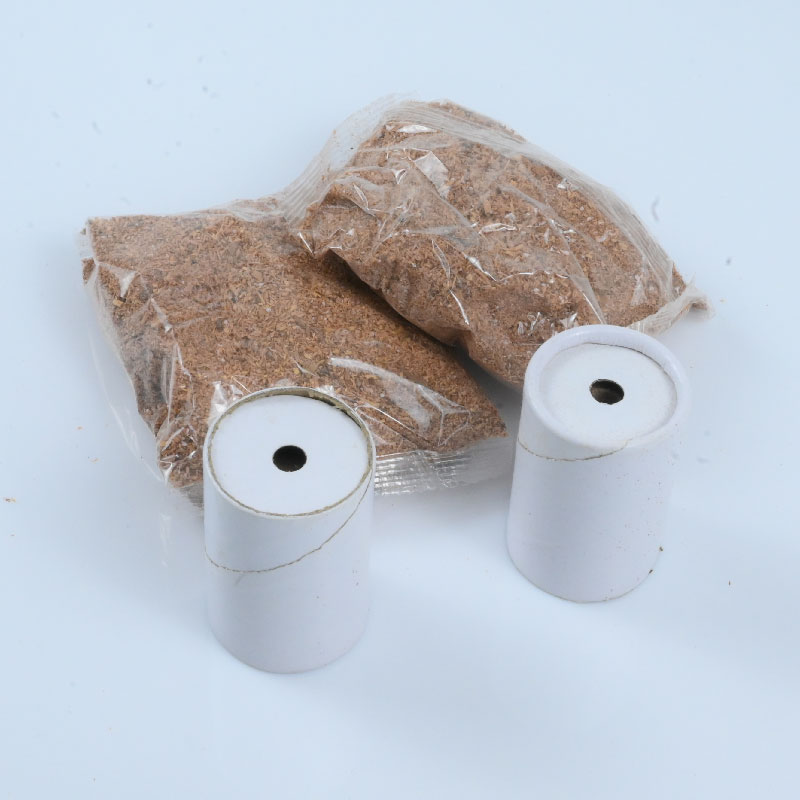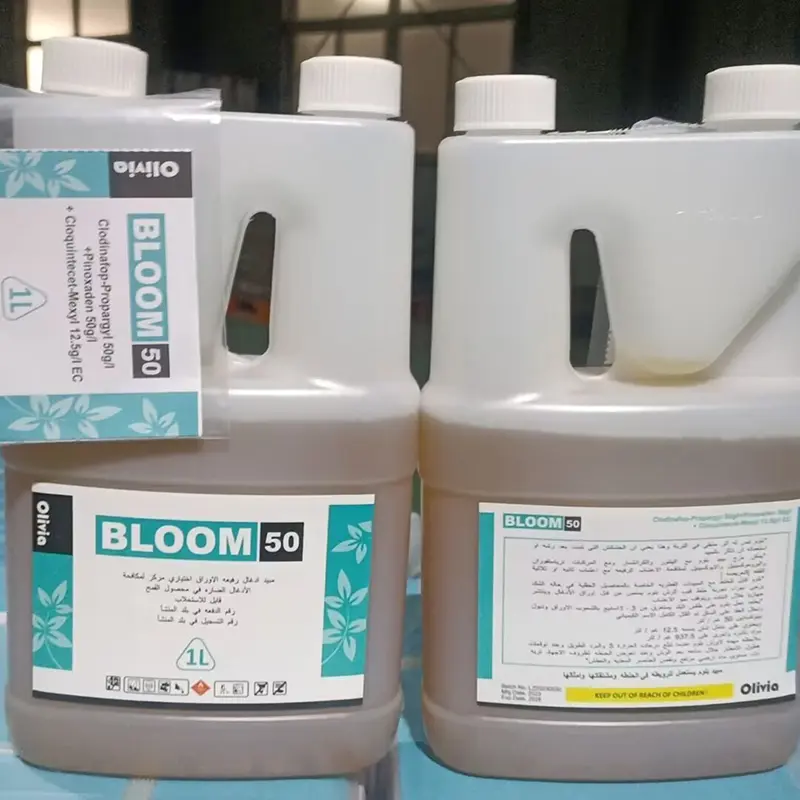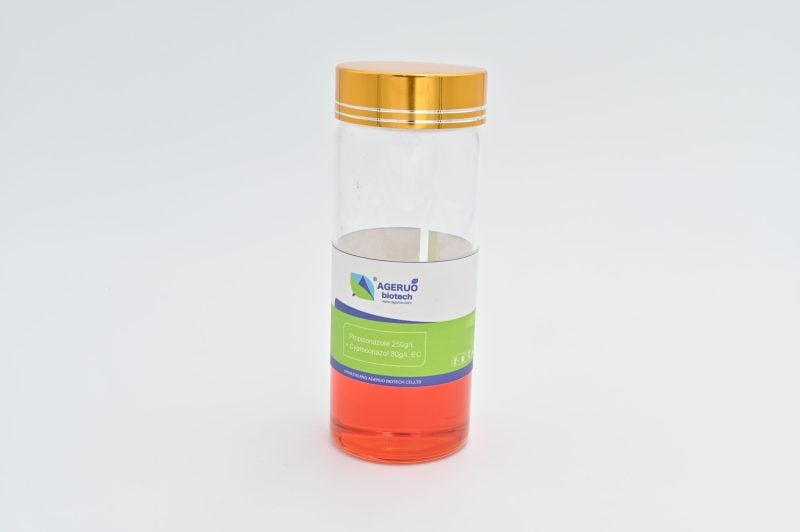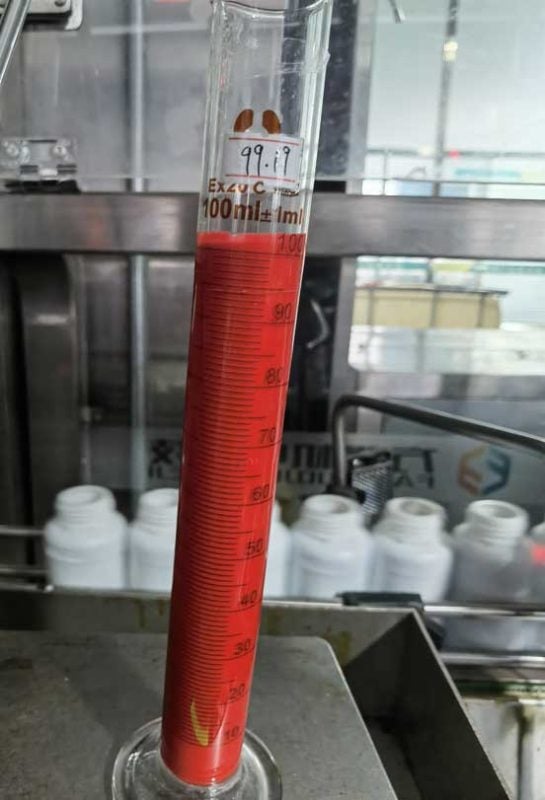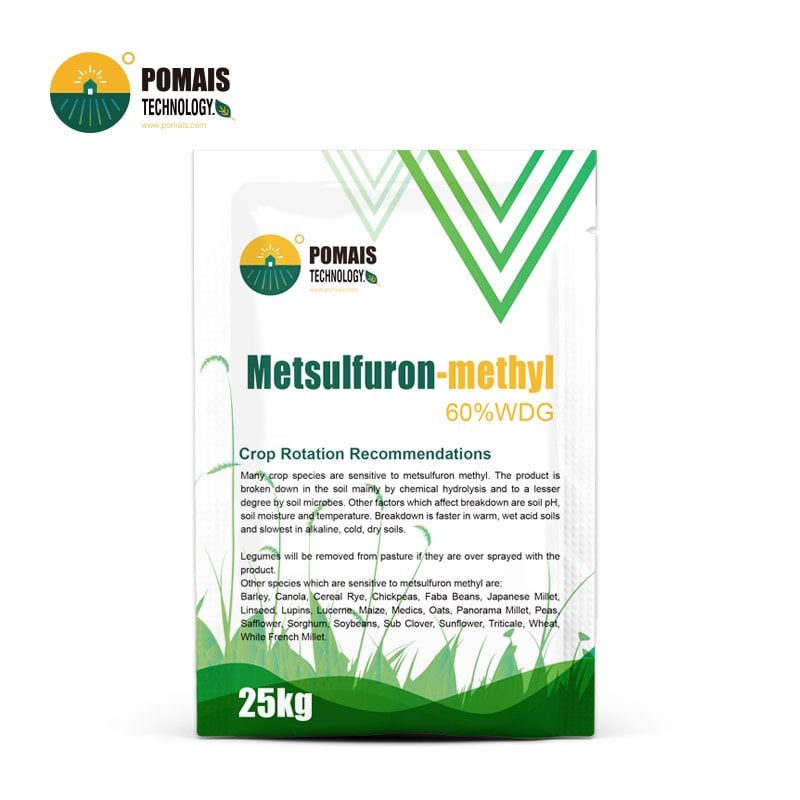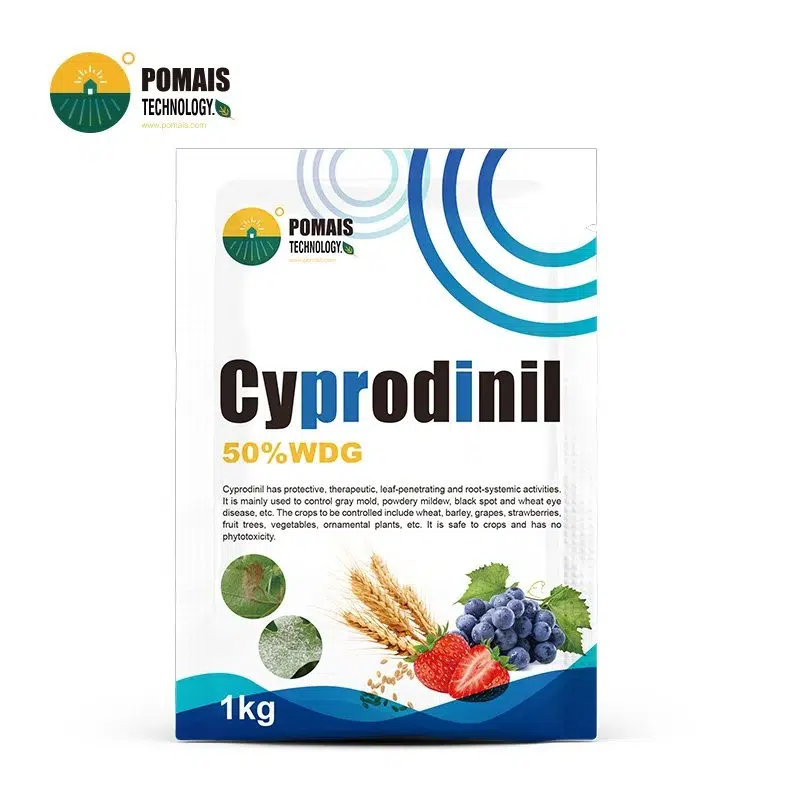Isoprocarb 10% + Beta-cypermethrin 5% FU | Aphid and Whitefly Control
You need rapid, label-compliant aphid and whitefly control in protected crops. This FU smoke generator combines isoprocarb 10% (IRAC 1A) and beta-cypermethrin 5% (IRAC 3A) with a synergist (3–5%) to deliver fast knockdown and full-space coverage.
In sealed greenhouse/net-house environments, the fine smoke disperses through dense canopies, reaches leaf undersides, and drives uniform deposition where sprays leave blind spots. You gain fast population reduction on piercing-sucking pests with practical residual suppression, while a dual-MoA + synergist design helps manage metabolic resistance pressure. Operations are straightforward—no tank mix, minimal water handling, and predictable night-time deployment with planned ventilation and REI re-entry. For procurement and brand execution, we support OEM labels, custom stick weights and carton specs, plus COA/MSDS/TDS. The result is a clean, repeatable protocol that raises control consistency and lowers labor per treated hectare.
- Full-space coverage:smoke reaches leaf backs and tight structures
- Fast knockdown:IRAC 1A + 3A action, synergist-enhanced
- Operational efficiency:no mixing water, low labor, predictable cycles
- OEM-ready:custom weights, multilingual labels, COA/MSDS/TDS
- Designed for Professional Buyers & Bulk Orders
- This product is available for business purchase and large-scale distribution.
- We support custom packaging, labeling, and formulation to meet your market needs.
- Let’s build your brand together.

About Isoprocarb 10% + Beta-cypermethrin 5% FU | Aphid and Whitefly Control
About Isoprocarb 10% + Beta-cypermethrin 5% FU | Aphid and Whitefly Control
| Product | Aphid & Whitefly Control FU Smoke Generator |
| Actives | Isoprocarb 10% (IRAC 1A) + Beta-cypermethrin 5% (IRAC 3A) |
| Synergist | 3–5% (metabolism inhibitor; enhances knockdown) |
| Formulation | FU (smoke stick; space-filling aerosol for full-structure coverage) |
| Primary Pests | Aphids, Whiteflies (label-dependent) |
| Use Sites | Greenhouse / Net-house protected crops |
| Operating Notes | Sealed exposure → label ventilation → REI re-entry |
| Documentation | COA / MSDS (SDS) / TDS, batch QC summary |
| OEM Options | Private label, multilingual labels, barcoding/QR, tamper-evident, optional serialization |
| Pack & Carton | Custom stick weights and carton counts; pallet patterns per lane |
| Storage | Cool, dry, away from ignition sources; original packaging |
| Compliance | GHS-aligned labeling; use strictly per local label and regulations |
Mode of Action — IRAC 1A + 3A with Synergist Support
You control aphids and whiteflies by combining two proven neuro-targets with a metabolism blocker: isoprocarb (IRAC 1A), beta-cypermethrin (IRAC 3A), and a synergist that suppresses detox enzymes to sustain knockdown.
Isoprocarb acts as a reversible acetylcholinesterase (AChE) inhibitor, disrupting synaptic signal termination and causing rapid overstimulation in piercing–sucking pests. Beta-cypermethrin modulates voltage-gated sodium channels, extending nerve firing and delivering fast knockdown. The synergist (3–5%)—commonly used to inhibit P450-mediated detoxification—elevates effective exposure inside the insect, improving performance where metabolic resistance is building. In FU smoke format, micronized actives travel with the smoke plume, deposit on leaf undersides and tight structures, and create a more uniform contact film than many spray passes in dense canopies. You gain rapid population collapse, practical residual suppression, and a cleaner path to rotate different IRAC groups in an IPM plan without over-relying on one chemistry.
- Dual neuromode: 1A AChE inhibition + 3A sodium-channel modulation
- Synergist boost: depresses detox enzymes; improves performance against metabolic resistance
- Smoke deposition: uniform reach into leaf backs, crevices, dense crop architecture
- IPM fit: rotate with other IRAC groups; schedule around beneficial release windows
Target Pests & Use Areas — Aphids, Whiteflies | Greenhouse / Net-house
You are targeting piercing–sucking pests in protected crops; this section clarifies host crops, structure types, and operating prerequisites so your smoke cycles hit pressure points without creating spray blind spots.
Primary targets (label-dependent)
- Aphids: green peach aphid (Myzus persicae), cotton/melon aphid (Aphis gossypii), and related species.
- Whiteflies: sweetpotato whitefly (Bemisia tabaci), greenhouse whitefly (Trialeurodes vaporariorum).
These pests colonize tender growth, leaf undersides, and dense canopies—areas the FU smoke reaches consistently.
Use areas & crop examples
- Greenhouse / net-house vegetables: tomato, cucumber, pepper, eggplant, leafy greens.
- Ornamentals & nurseries: cut flowers, potted ornamentals, plug trays.
- Seedling & propagation zones: high plant density, frequent pest hotspots.
Final crop list and use permissions are label-specific for your market.
When this format excels
- Canopy is dense and leaf undersides are hard to wet with sprays.
- Night or off-hours deployment is possible for sealed fumigation and planned ventilation.
- You need fast knockdown plus uniform deposition across benches, racks, and tight structures.
Operational prerequisites (high-level)
- Seal the structure to contain smoke; shut fans per label.
- Evacuate personnel; ventilate to meet REI before re-entry.
- Coordinate with beneficials: avoid use during pollinator release and peak activity of parasitoids/predators; schedule windows to protect IPM assets.
Application Principles — Label-Guided Fumigation & Re-Entry Safety
You deploy the FU smoke generator in sealed structures under the product label to maximize uniform deposition while protecting workers, beneficials, and crops. The goal is fast knockdown with predictable cycles and clean re-entry.
Pre-checks (before deployment)
- Seal the structure: close vents, doors, and gaps; shut fans as the label directs.
- Safety readiness: confirm PPE, signage, and a ventilation plan; remove ignition sources and flammables from the treatment zone.
- Crop & climate fit: target off-hours/night; avoid overhead irrigation immediately before use; ensure foliage is dry and benches/aisles are clear.
Placement & activation (label-dependent)
- Distribute sticks to cover the space uniformly; place on non-flammable, stable surfaces with adequate clearance.
- Activate per label and evacuate personnel promptly; maintain the exposure period without opening the structure.
Ventilation & re-entry
- Ventilate according to the label and local regulations until the structure reaches the REI condition; verify airflow paths for even exchange.
- Resume operations in stages if needed (e.g., sensitive areas last), and document re-entry time and checks.
IPM coordination
- Schedule around beneficials (pollinators, parasitoids, predators); avoid releases or peak activity windows.
- Integrate with IRAC rotations and sanitation (screens, scouting, sticky cards) to manage pressure between cycles.
Operational Do / Don’t
- Do keep a log of date, crop stage, structure status, and ventilation endpoints.
- Do store canisters cool and dry; handle ash/residue per local disposal rules.
- Don’t run fans or open vents during exposure unless the label explicitly allows.
- Don’t disclose or use prescriptive dose/time beyond the approved label.
FU Formulation Advantages — Full-Space Coverage, Low Labor
You need uniform deposition in dense canopies without water handling. The FU smoke generator produces fine aerosolized actives that fill the structure, settle onto leaf undersides and crevices, and standardize outcomes across benches and racks.
Coverage dynamics
- Full-space reach: smoke disperses uniformly in sealed structures, minimizing spray blind spots on leaf backs and tight plant architecture.
- Even settling: gravity-driven deposition creates a consistent contact film across upper/lower foliage, frames, and hard-to-wet zones.
Deposition quality
- Micronized actives ride the smoke plume for high leaf-surface contact.
- No water spots or run-off lines; cleaner finish on ornamentals and sensitive foliage.
Operational efficiency
- No mixing water or nozzle calibration; night/off-hour deployment aligns with re-entry planning.
- Repeatable cycles reduce operator variability and lower labor per treated hectare.
Handling & storage
- Compact sticks simplify inventory and transport; tamper-evident and serialized options support traceability.
- Store cool, dry, away from ignition sources; keep to label-listed fire safety measures.
IPM & Resistance Management — Rotate Modes, Protect Beneficials
You keep knockdown strong and resistance slow by rotating IRAC groups, timing smoke cycles around beneficials, and tightening greenhouse hygiene so re-infestation does not erase your gains.
Rotation & cadence
- Alternate IRAC groups across the season; avoid back-to-back cycles of 1A/3A when pressure allows.
- Use the FU cycle to reset pest levels, then rotate to a different MoA (spray or biological) per label and program design.
- Space interventions from scouting thresholds, not fixed calendars; tighten cadence only when monitoring data shows trend breaks.
Beneficials & pollinators
- Do not deploy during pollinator release or peak parasitoid/predator activity; schedule night/off-hours and re-introduce beneficials after ventilation and REI.
- Keep a compatibility matrix for your predators/parasitoids; align releases 24–72 h post-ventilation as your biocontrol supplier recommends.
Hygiene & exclusion
- Maintain insect screens, door protocols, and quarantine for incoming plant material.
- Remove hotspot plants and spent crop residues quickly; sanitize benches, gutters, and floor cracks where pest stages persist.
- Use sticky cards and geo-tagged counts to map hotspots; escalate only where data supports it.
Data discipline
- Log date/time, structure status, crop stage, REI clearance, and post-treatment counts.
- Review weekly to adjust rotation sequence, cycle spacing, and biological re-inoculation timing.
Regulatory & Stewardship — GHS-Aligned, REI/PHI Compliance
You keep operations compliant by running smoke cycles exactly to the label, documenting each pass, and aligning worker protection, ventilation, and disposal with GHS/WHMIS/REACH communication and local rules.
Label & legal use
- Use only on labeled crops/sites and structure types; follow precautions, exposure periods, and ventilation directives verbatim.
- Do not substitute label guidance with facility SOPs; SOPs must inherit the label.
Worker protection (REI/PHI & PPE)
- Respect REI/PHI intervals and PPE requirements listed on the label/SDS.
- Evacuate personnel before activation; control access until re-entry criteria are met and recorded.
Ventilation & fire safety
- Treat as a smoke/fumigation event: seal for exposure, then ventilate to label thresholds.
- Keep ignition sources out of the treatment zone; stage signage, extinguishers, and alarms per facility policy and local code.
Non-target & beneficials
- Protect pollinators and biological control agents: schedule cycles outside release/peak activity windows and reintroduce only after REI and ventilation.
- Observe any buffer or exclusion statements on the label.
Waste, storage & transport
- Store cool, dry, away from heat/flames in original packaging; rotate stock FIFO.
- Manage ash/residue and empty packaging under local disposal rules; keep a chain of custody for audits.
Documentation package
- Maintain COA/MSDS/TDS, training records, cycle logs (date/time, structure ID, exposure, ventilation, REI clearance), and incident/near-miss reports.
- Align with internal EHS reviews and distributor audits; keep documents accessible at the site of use.
OEM & Packaging — Custom Weights, Multilingual Labels, Traceability
You need ready-to-sell packs with audit-proof traceability. We deliver private-label OEM, custom stick weights and carton specs, multilingual labels, and a full COA/MSDS/TDS pack to de-risk procurement and distributor onboarding.
Pack formats & customization
- FU smoke sticks in custom weights; standard or made-to-fit carton counts for your greenhouse layout and handling SOPs.
- Moisture-safe inner and ship-ready outers; pallet patterns and cartonization notes aligned to your lanes.
Labeling & artwork
- Multilingual labels with GHS panels, hazard statements, and use-site cues; label templates supplied to accelerate compliance checks.
- Brand assets locked to your guidelines (logos, color, typography) for consistent shelf and audit presence.
Traceability & security
- Batch coding, GS1 barcoding, QR links to lot docs; tamper-evident seals and optional serialization for high-control channels.
- On-carton and inner-unit IDs to keep warehouse moves and distributor returns clean.
Documentation & onboarding
- COA/MSDS/TDS with batch QC summary; quick-start sheets for operations, ventilation planning, and REI signage placement.
- Sample kits for stakeholder training and customer acceptance.
Logistics & service levels
- Forecast-based slotting and a defined lead-time window; MOQ by pack and market, confirmed at quotation.
- Export paperwork and HS guidance coordinated with your broker (final compliance per local authority).
Field Use Scenarios — Night Deployment, Dense Canopies, Propagation Zones
You get consistent knockdown when smoke cycles are scheduled off-hours, structures are sealed, and canopy architecture would otherwise create spray blind spots. These examples translate the format into predictable greenhouse outcomes.
Greenhouse Tomato — Night Cycle in Dense Vines
Run the FU smoke after the last working shift with vents closed and fans off per label. The plume threads through trellised vines and fruit clusters, settling on leaf undersides where aphids and whiteflies concentrate. Plan ventilation for the first window next morning, confirm REI, and reintroduce beneficials as your IPM supplier advises. Expect cleaner shoots and fewer hot spots versus repeated spray passes in heavy growth.
Ornamental Cut Flowers — Coverage Without Water Spots
In cut-flower bays and mother blocks, the dry smoke leaves no water marks and deposits evenly across delicate foliage and tight calyx areas. Use custom stick counts to match bay volume; stage signage, activation, and timed ventilation to protect staff and visitor routes. Align cycles away from pollinator activity and parasitoid release windows to preserve biological assets.
Vegetable Propagation / Plug Trays — Uniform Bench Reach
High plant density and bench shelving create persistent refuges for piercing–sucking pests. The smoke plume fills aisles and racks, settling into crevices and tray undersides to standardize deposition. Rotate with different IRAC groups between cycles and maintain screens/sanitation so incoming material does not reseed pressure. Log structure status, exposure, ventilation end-points, and post-cycle counts for audits.
FAQ
Q1. Is this an in-storage fumigant?
No. It is an FU smoke generator for sealed greenhouse/net-house structures. You activate in the structure, run the labeled exposure, then ventilate to REI before re-entry.
Q2. Can I use it while pollinators or beneficials are active?
Avoid use during pollinator release and peak parasitoid/predator activity. Schedule night/off-hours cycles and reintroduce beneficials after ventilation and REI are met.
Q3. What pests does it target?
Label-dependent aphids and whiteflies in protected crops. The isoprocarb 10% (IRAC 1A) + beta-cypermethrin 5% (IRAC 3A) + synergist (3–5%) system delivers fast knockdown and uniform deposition.
Q4. How does it compare to conventional spraying?
The smoke fills space and reaches leaf undersides/crevices where sprays can leave blind spots, reducing labor tied to nozzle calibration and water handling. You still integrate sprays and IRAC rotations within IPM.
Q5. What about REI/PHI and ventilation?
Follow the product label and local regulations for REI/PHI, evacuation, sealing, and ventilation thresholds. Document cycle start, exposure end, ventilation times, and re-entry clearance.
Q6. What documents are supplied?
Each batch ships with COA / MSDS (SDS) / TDS and a batch QC summary. Label templates are provided for multilingual OEM checks.
Q7. What pack formats and OEM options are available?
Custom stick weights and carton counts, multilingual labels, barcoding/QR, tamper-evident options, and optional serialization for high-control channels.
Q8. Lead time and MOQ?
Typical lead-time window: 20–30 days(forecast-based slotting);MOQ depends on stick weight and market. Final terms confirmed at quotation.
Q9. Storage and transport?
Store cool, dry, away from ignition sources in original packaging. Handle ash/residue and empties per local disposal rules; keep traceability records.
Q10. Can you share dose or cycle time?
No prescriptive rates or timings are disclosed here. Use strictly per the approved label for your market and crop.
Why Choose POMAIS — Delivery Certainty, OEM Speed, QC Proof
You want a smoke generator that performs in the house and passes an audit outside it. We back the product with engineered formulation, documented QC, and predictable delivery so your season plan holds.
- Engineered FU performance:uniform smoke deposition for leaf-underside coverage in dense canopies.
- QC you can verify:batch COA/MSDS/TDS, HPLC release, stability checks; traceable barcoding/QR and optional serialization.
- Compliance-ready labels:multilingual artwork with GHS panels; label templates accelerate local reviews.
- OEM at pace:custom stick weights、carton counts、tamper-evident options; design locked to your brand specs.
- Delivery you can plan:forecast-based slotting、clear 20–30 day lead-time window、export paperwork coordinated with your broker.
- Market-fit support:playbooks for sealing/ventilation, REI signage, beneficial coordination, and IPM rotation positioning.
Partner with POMAIS Today — Get Specs, Samples, and a Lead-Time Window
Request your pack-ready bundle and align production to your import lane. We will tailor weights, cartons, and documentation to your greenhouse program.
- Send: facility size & layout, crops, current pest pressure, preferred stick weight and carton count, destination port, target ship window.
- Receive: spec sheet, label templates, samples, COA/MSDS/TDS, MOQ & lead-time confirmation, palletization notes, and HS guidance for clearance.
| Product | Aphid & Whitefly Control FU Smoke Generator |
| Actives | Isoprocarb 10% (IRAC 1A) + Beta-cypermethrin 5% (IRAC 3A) |
| Synergist | 3–5% (metabolism inhibitor; enhances knockdown) |
| Formulation | FU (smoke stick; space-filling aerosol for full-structure coverage) |
| Primary Pests | Aphids, Whiteflies (label-dependent) |
| Use Sites | Greenhouse / Net-house protected crops |
| Operating Notes | Sealed exposure → label ventilation → REI re-entry |
| Documentation | COA / MSDS (SDS) / TDS, batch QC summary |
| OEM Options | Private label, multilingual labels, barcoding/QR, tamper-evident, optional serialization |
| Pack & Carton | Custom stick weights and carton counts; pallet patterns per lane |
| Storage | Cool, dry, away from ignition sources; original packaging |
| Compliance | GHS-aligned labeling; use strictly per local label and regulations |
Mode of Action — IRAC 1A + 3A with Synergist Support
You control aphids and whiteflies by combining two proven neuro-targets with a metabolism blocker: isoprocarb (IRAC 1A), beta-cypermethrin (IRAC 3A), and a synergist that suppresses detox enzymes to sustain knockdown.
Isoprocarb acts as a reversible acetylcholinesterase (AChE) inhibitor, disrupting synaptic signal termination and causing rapid overstimulation in piercing–sucking pests. Beta-cypermethrin modulates voltage-gated sodium channels, extending nerve firing and delivering fast knockdown. The synergist (3–5%)—commonly used to inhibit P450-mediated detoxification—elevates effective exposure inside the insect, improving performance where metabolic resistance is building. In FU smoke format, micronized actives travel with the smoke plume, deposit on leaf undersides and tight structures, and create a more uniform contact film than many spray passes in dense canopies. You gain rapid population collapse, practical residual suppression, and a cleaner path to rotate different IRAC groups in an IPM plan without over-relying on one chemistry.
- Dual neuromode: 1A AChE inhibition + 3A sodium-channel modulation
- Synergist boost: depresses detox enzymes; improves performance against metabolic resistance
- Smoke deposition: uniform reach into leaf backs, crevices, dense crop architecture
- IPM fit: rotate with other IRAC groups; schedule around beneficial release windows
Target Pests & Use Areas — Aphids, Whiteflies | Greenhouse / Net-house
You are targeting piercing–sucking pests in protected crops; this section clarifies host crops, structure types, and operating prerequisites so your smoke cycles hit pressure points without creating spray blind spots.
Primary targets (label-dependent)
- Aphids: green peach aphid (Myzus persicae), cotton/melon aphid (Aphis gossypii), and related species.
- Whiteflies: sweetpotato whitefly (Bemisia tabaci), greenhouse whitefly (Trialeurodes vaporariorum).
These pests colonize tender growth, leaf undersides, and dense canopies—areas the FU smoke reaches consistently.
Use areas & crop examples
- Greenhouse / net-house vegetables: tomato, cucumber, pepper, eggplant, leafy greens.
- Ornamentals & nurseries: cut flowers, potted ornamentals, plug trays.
- Seedling & propagation zones: high plant density, frequent pest hotspots.
Final crop list and use permissions are label-specific for your market.
When this format excels
- Canopy is dense and leaf undersides are hard to wet with sprays.
- Night or off-hours deployment is possible for sealed fumigation and planned ventilation.
- You need fast knockdown plus uniform deposition across benches, racks, and tight structures.
Operational prerequisites (high-level)
- Seal the structure to contain smoke; shut fans per label.
- Evacuate personnel; ventilate to meet REI before re-entry.
- Coordinate with beneficials: avoid use during pollinator release and peak activity of parasitoids/predators; schedule windows to protect IPM assets.
Application Principles — Label-Guided Fumigation & Re-Entry Safety
You deploy the FU smoke generator in sealed structures under the product label to maximize uniform deposition while protecting workers, beneficials, and crops. The goal is fast knockdown with predictable cycles and clean re-entry.
Pre-checks (before deployment)
- Seal the structure: close vents, doors, and gaps; shut fans as the label directs.
- Safety readiness: confirm PPE, signage, and a ventilation plan; remove ignition sources and flammables from the treatment zone.
- Crop & climate fit: target off-hours/night; avoid overhead irrigation immediately before use; ensure foliage is dry and benches/aisles are clear.
Placement & activation (label-dependent)
- Distribute sticks to cover the space uniformly; place on non-flammable, stable surfaces with adequate clearance.
- Activate per label and evacuate personnel promptly; maintain the exposure period without opening the structure.
Ventilation & re-entry
- Ventilate according to the label and local regulations until the structure reaches the REI condition; verify airflow paths for even exchange.
- Resume operations in stages if needed (e.g., sensitive areas last), and document re-entry time and checks.
IPM coordination
- Schedule around beneficials (pollinators, parasitoids, predators); avoid releases or peak activity windows.
- Integrate with IRAC rotations and sanitation (screens, scouting, sticky cards) to manage pressure between cycles.
Operational Do / Don’t
- Do keep a log of date, crop stage, structure status, and ventilation endpoints.
- Do store canisters cool and dry; handle ash/residue per local disposal rules.
- Don’t run fans or open vents during exposure unless the label explicitly allows.
- Don’t disclose or use prescriptive dose/time beyond the approved label.
FU Formulation Advantages — Full-Space Coverage, Low Labor
You need uniform deposition in dense canopies without water handling. The FU smoke generator produces fine aerosolized actives that fill the structure, settle onto leaf undersides and crevices, and standardize outcomes across benches and racks.
Coverage dynamics
- Full-space reach: smoke disperses uniformly in sealed structures, minimizing spray blind spots on leaf backs and tight plant architecture.
- Even settling: gravity-driven deposition creates a consistent contact film across upper/lower foliage, frames, and hard-to-wet zones.
Deposition quality
- Micronized actives ride the smoke plume for high leaf-surface contact.
- No water spots or run-off lines; cleaner finish on ornamentals and sensitive foliage.
Operational efficiency
- No mixing water or nozzle calibration; night/off-hour deployment aligns with re-entry planning.
- Repeatable cycles reduce operator variability and lower labor per treated hectare.
Handling & storage
- Compact sticks simplify inventory and transport; tamper-evident and serialized options support traceability.
- Store cool, dry, away from ignition sources; keep to label-listed fire safety measures.
IPM & Resistance Management — Rotate Modes, Protect Beneficials
You keep knockdown strong and resistance slow by rotating IRAC groups, timing smoke cycles around beneficials, and tightening greenhouse hygiene so re-infestation does not erase your gains.
Rotation & cadence
- Alternate IRAC groups across the season; avoid back-to-back cycles of 1A/3A when pressure allows.
- Use the FU cycle to reset pest levels, then rotate to a different MoA (spray or biological) per label and program design.
- Space interventions from scouting thresholds, not fixed calendars; tighten cadence only when monitoring data shows trend breaks.
Beneficials & pollinators
- Do not deploy during pollinator release or peak parasitoid/predator activity; schedule night/off-hours and re-introduce beneficials after ventilation and REI.
- Keep a compatibility matrix for your predators/parasitoids; align releases 24–72 h post-ventilation as your biocontrol supplier recommends.
Hygiene & exclusion
- Maintain insect screens, door protocols, and quarantine for incoming plant material.
- Remove hotspot plants and spent crop residues quickly; sanitize benches, gutters, and floor cracks where pest stages persist.
- Use sticky cards and geo-tagged counts to map hotspots; escalate only where data supports it.
Data discipline
- Log date/time, structure status, crop stage, REI clearance, and post-treatment counts.
- Review weekly to adjust rotation sequence, cycle spacing, and biological re-inoculation timing.
Regulatory & Stewardship — GHS-Aligned, REI/PHI Compliance
You keep operations compliant by running smoke cycles exactly to the label, documenting each pass, and aligning worker protection, ventilation, and disposal with GHS/WHMIS/REACH communication and local rules.
Label & legal use
- Use only on labeled crops/sites and structure types; follow precautions, exposure periods, and ventilation directives verbatim.
- Do not substitute label guidance with facility SOPs; SOPs must inherit the label.
Worker protection (REI/PHI & PPE)
- Respect REI/PHI intervals and PPE requirements listed on the label/SDS.
- Evacuate personnel before activation; control access until re-entry criteria are met and recorded.
Ventilation & fire safety
- Treat as a smoke/fumigation event: seal for exposure, then ventilate to label thresholds.
- Keep ignition sources out of the treatment zone; stage signage, extinguishers, and alarms per facility policy and local code.
Non-target & beneficials
- Protect pollinators and biological control agents: schedule cycles outside release/peak activity windows and reintroduce only after REI and ventilation.
- Observe any buffer or exclusion statements on the label.
Waste, storage & transport
- Store cool, dry, away from heat/flames in original packaging; rotate stock FIFO.
- Manage ash/residue and empty packaging under local disposal rules; keep a chain of custody for audits.
Documentation package
- Maintain COA/MSDS/TDS, training records, cycle logs (date/time, structure ID, exposure, ventilation, REI clearance), and incident/near-miss reports.
- Align with internal EHS reviews and distributor audits; keep documents accessible at the site of use.
OEM & Packaging — Custom Weights, Multilingual Labels, Traceability
You need ready-to-sell packs with audit-proof traceability. We deliver private-label OEM, custom stick weights and carton specs, multilingual labels, and a full COA/MSDS/TDS pack to de-risk procurement and distributor onboarding.
Pack formats & customization
- FU smoke sticks in custom weights; standard or made-to-fit carton counts for your greenhouse layout and handling SOPs.
- Moisture-safe inner and ship-ready outers; pallet patterns and cartonization notes aligned to your lanes.
Labeling & artwork
- Multilingual labels with GHS panels, hazard statements, and use-site cues; label templates supplied to accelerate compliance checks.
- Brand assets locked to your guidelines (logos, color, typography) for consistent shelf and audit presence.
Traceability & security
- Batch coding, GS1 barcoding, QR links to lot docs; tamper-evident seals and optional serialization for high-control channels.
- On-carton and inner-unit IDs to keep warehouse moves and distributor returns clean.
Documentation & onboarding
- COA/MSDS/TDS with batch QC summary; quick-start sheets for operations, ventilation planning, and REI signage placement.
- Sample kits for stakeholder training and customer acceptance.
Logistics & service levels
- Forecast-based slotting and a defined lead-time window; MOQ by pack and market, confirmed at quotation.
- Export paperwork and HS guidance coordinated with your broker (final compliance per local authority).
Field Use Scenarios — Night Deployment, Dense Canopies, Propagation Zones
You get consistent knockdown when smoke cycles are scheduled off-hours, structures are sealed, and canopy architecture would otherwise create spray blind spots. These examples translate the format into predictable greenhouse outcomes.
Greenhouse Tomato — Night Cycle in Dense Vines
Run the FU smoke after the last working shift with vents closed and fans off per label. The plume threads through trellised vines and fruit clusters, settling on leaf undersides where aphids and whiteflies concentrate. Plan ventilation for the first window next morning, confirm REI, and reintroduce beneficials as your IPM supplier advises. Expect cleaner shoots and fewer hot spots versus repeated spray passes in heavy growth.
Ornamental Cut Flowers — Coverage Without Water Spots
In cut-flower bays and mother blocks, the dry smoke leaves no water marks and deposits evenly across delicate foliage and tight calyx areas. Use custom stick counts to match bay volume; stage signage, activation, and timed ventilation to protect staff and visitor routes. Align cycles away from pollinator activity and parasitoid release windows to preserve biological assets.
Vegetable Propagation / Plug Trays — Uniform Bench Reach
High plant density and bench shelving create persistent refuges for piercing–sucking pests. The smoke plume fills aisles and racks, settling into crevices and tray undersides to standardize deposition. Rotate with different IRAC groups between cycles and maintain screens/sanitation so incoming material does not reseed pressure. Log structure status, exposure, ventilation end-points, and post-cycle counts for audits.
FAQ
Q1. Is this an in-storage fumigant?
No. It is an FU smoke generator for sealed greenhouse/net-house structures. You activate in the structure, run the labeled exposure, then ventilate to REI before re-entry.
Q2. Can I use it while pollinators or beneficials are active?
Avoid use during pollinator release and peak parasitoid/predator activity. Schedule night/off-hours cycles and reintroduce beneficials after ventilation and REI are met.
Q3. What pests does it target?
Label-dependent aphids and whiteflies in protected crops. The isoprocarb 10% (IRAC 1A) + beta-cypermethrin 5% (IRAC 3A) + synergist (3–5%) system delivers fast knockdown and uniform deposition.
Q4. How does it compare to conventional spraying?
The smoke fills space and reaches leaf undersides/crevices where sprays can leave blind spots, reducing labor tied to nozzle calibration and water handling. You still integrate sprays and IRAC rotations within IPM.
Q5. What about REI/PHI and ventilation?
Follow the product label and local regulations for REI/PHI, evacuation, sealing, and ventilation thresholds. Document cycle start, exposure end, ventilation times, and re-entry clearance.
Q6. What documents are supplied?
Each batch ships with COA / MSDS (SDS) / TDS and a batch QC summary. Label templates are provided for multilingual OEM checks.
Q7. What pack formats and OEM options are available?
Custom stick weights and carton counts, multilingual labels, barcoding/QR, tamper-evident options, and optional serialization for high-control channels.
Q8. Lead time and MOQ?
Typical lead-time window: 20–30 days(forecast-based slotting);MOQ depends on stick weight and market. Final terms confirmed at quotation.
Q9. Storage and transport?
Store cool, dry, away from ignition sources in original packaging. Handle ash/residue and empties per local disposal rules; keep traceability records.
Q10. Can you share dose or cycle time?
No prescriptive rates or timings are disclosed here. Use strictly per the approved label for your market and crop.
Why Choose POMAIS — Delivery Certainty, OEM Speed, QC Proof
You want a smoke generator that performs in the house and passes an audit outside it. We back the product with engineered formulation, documented QC, and predictable delivery so your season plan holds.
- Engineered FU performance:uniform smoke deposition for leaf-underside coverage in dense canopies.
- QC you can verify:batch COA/MSDS/TDS, HPLC release, stability checks; traceable barcoding/QR and optional serialization.
- Compliance-ready labels:multilingual artwork with GHS panels; label templates accelerate local reviews.
- OEM at pace:custom stick weights、carton counts、tamper-evident options; design locked to your brand specs.
- Delivery you can plan:forecast-based slotting、clear 20–30 day lead-time window、export paperwork coordinated with your broker.
- Market-fit support:playbooks for sealing/ventilation, REI signage, beneficial coordination, and IPM rotation positioning.
Partner with POMAIS Today — Get Specs, Samples, and a Lead-Time Window
Request your pack-ready bundle and align production to your import lane. We will tailor weights, cartons, and documentation to your greenhouse program.
- Send: facility size & layout, crops, current pest pressure, preferred stick weight and carton count, destination port, target ship window.
- Receive: spec sheet, label templates, samples, COA/MSDS/TDS, MOQ & lead-time confirmation, palletization notes, and HS guidance for clearance.
Related Products
Latest News

